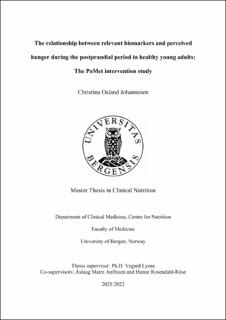| dc.description.abstract | Background: A lot of research has been conducted on the field of appetite regulation. However, less in known about the impact of the metabolic switch and the increasing ketone production on subjective feelings of hunger and satiety during postprandial adaptation in healthy, young men and woman. Objective: Focusing on dynamic changes in plasma glucose, insulin concentrations and ketones, the primary objective was to explore the relationship between relevant biomarkers and perceived hunger, satiety, and desire for food during postprandial adaption in healthy, young adults. Methods: Thirty-six healthy adults aged 20-30 years with a body mass index of 22-27 kg/m2, was served a standardized breakfast meal before fasting for 24 hours. Venous blood samples were drawn at 13 time points during the postprandial period. The samples were collected frequently during the first four hours, then every other hour for the subsequent eight hours up to 12 hours. Additionally, one last blood sample was conducted the following morning, 24 hours after the meal. Biomarker concentrations was measured using a targeted metabolomics approach, (body composition was measured by air displacement plethysmography using a BodPod), and data on perceived hunger, satiety and desire for food was assessed through a set of 14 visual analogue scales, filled out by the participant at each blood sampling. Results: Overall, we observed an expected increase in concentrations of glucose and insulin immediately after food consumption, peaking at approximately one hour, before returning to baseline values. For the ketones, the lowest concentrations were observed during the early postprandial period, followed by a gradual increased throughout the intervention. Moderate to strong correlations were observed between the biomarkers and the parameters of perceived hunger, satiety, and desire for food. Conclusion: In this study, glucose and insulin were associated with less hunger and more satiety, while the opposite was observed for the ketones. However, more research is needed in order to account for day-to-day variations and strengthen the validity of the results. Future research should involve longer study duration with repetitive interventions to provide a stronger basis to explore the potential impact of the metabolic switch and ketone production on perceived hunger and satiety, and further supplement the findings of the current study with measurements of established hormones related to hunger and satiety. | |
